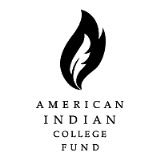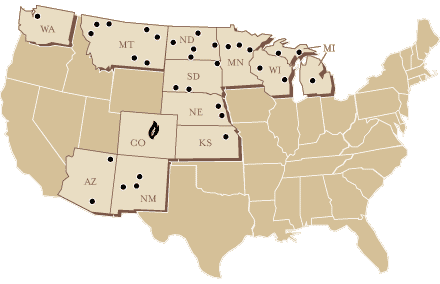
American Indian College Fund
Encyclopedia

Nonprofit organization
Nonprofit organization is neither a legal nor technical definition but generally refers to an organization that uses surplus revenues to achieve its goals, rather than distributing them as profit or dividends...
that helps Native American
Indigenous peoples of the Americas
The indigenous peoples of the Americas are the pre-Columbian inhabitants of North and South America, their descendants and other ethnic groups who are identified with those peoples. Indigenous peoples are known in Canada as Aboriginal peoples, and in the United States as Native Americans...
students, providing them with support through scholarships and funding toward higher education. The Fund provides 5,000 annual scholarships for American Indian students and also provides support for other needs at the tribal colleges
Tribal colleges and universities
Tribal colleges and universities are a category of higher education, minority-serving institutions in the United States. The educational institutions are distinguished by being controlled and operated by Native American tribes; they have become part of American Indians' institution-building in...
ranging from capital support to cultural preservation activities.
History and Mission
During the Civil Rights Acts and Native American self-determinationNative American self-determination
Native American self-determination refers to the social movements, legislation, and beliefs by which the tribes in the United States exercise self-governance and decision making on issues that affect their own people...
movements in 1960s, many tribes and tribal leaders came to the decision that there was a need for change in failed federal education policy
Education policy
Education policy refers to the collection of laws and rules that govern the operation of education systems.Education occurs in many forms for many purposes through many institutions. Examples include early childhood education, kindergarten through to 12th grade, two and four year colleges or...
and improve education for Native American students and future generations. During this time of change and growth, tribal colleges and universities were born.
The American Indian College Fund was launched in 1989 and raised funds from private sector sources to provide scholarship support to the tribal colleges. This was the primary mission of the Fund, to generate broad awareness of those institutions and the Fund itself. The organization also raises money and resources for other needs at the schools, including capital projects, operations, endowments or program initiatives, and it will conduct fund raising and related activities for Board-directed initiatives. The American Indian College Fund made higher education, knowledge, and the enhancement and enrichment of culture more accessible and available for Native American students located in more rural areas of the country.
Originally located in New York City
New York City
New York is the most populous city in the United States and the center of the New York Metropolitan Area, one of the most populous metropolitan areas in the world. New York exerts a significant impact upon global commerce, finance, media, art, fashion, research, technology, education, and...
, the Fund headquarters were relocated to Denver, Colorado
Denver, Colorado
The City and County of Denver is the capital and the most populous city of the U.S. state of Colorado. Denver is a consolidated city-county, located in the South Platte River Valley on the western edge of the High Plains just east of the Front Range of the Rocky Mountains...
in 2002.
The idea for an Indian college fund was first proposed by Jan Crull Jr.,an aide to U.S. Congressman Paul Simon
Paul Simon (politician)
Paul Martin Simon was an American politician from Illinois. He served in the United States House of Representatives from 1975 to 1985 and United States Senate from 1985 to 1997. He was a member of the Democratic Party...
the then chairman of the U.S. House Subcommittee on Postsecondary Education, to the tribal college presidents and many other tribal officials assembled at the old American Indian Bank in Washington, D.C., on July 21, 1981.
Tribal Colleges
Tribal colleges are vital to Native Americans and are beneficial to the country as a whole. They help Native communities and students gain a valuable education to help fight the poverty and unemployment within Indian Country and to also help in preserving Native language, culture and traditions.The Navajo Nation
Navajo Nation
The Navajo Nation is a semi-autonomous Native American-governed territory covering , occupying all of northeastern Arizona, the southeastern portion of Utah, and northwestern New Mexico...
was the first tribe to create the first tribal college, called Diné College, that was controlled by the tribe, located on the reservation and established specifically for the Native American students that wished to gain a higher education in 1968. With this first tribal college, the movement for higher education for the American Indian began. Since then, the number of tribal colleges and universities has grown to over 30 in the United States and 1 in Canada. The tribal colleges are located in Arizona, California, Iowa, Kansas, Michigan, Montana, Nebraska, New Mexico, North Dakota, South Dakota, Washington, and Wisconsin and served more than 250 American Indian Nations from every geographic region in the United States.
TCUs are very important to all they serve. They receive little to no financial support. They also do not receive any local or state tax support and run mainly on private donations and gifts from foundations such as the AICF.

Past and Present Public Service Campaigns
The American Indian College Fund teamed up with Portland, Oregon-based advertising agency partner, Wieden+KennedyWieden+Kennedy
Wieden+Kennedy is an independently owned American advertising agency best known for its work for Nike...
, to give hope to Native Americans everywhere. In 2006, they launched a new campaign for the Fund called "If I Stay on the Rez" It is a series of five ads highlighting students who have attended a tribal college and plan to use their education on the reservation to help their people. The campaign builds awareness for the preservation of American Indian culture and history through tribal colleges. Richard B. Williams, the Fund president and CEO, says, "The American Indian College Fund video is unique opportunity to see a very important part of Indian country. We are educating the mind and spirit, and this is captured in the video."
In 2009, The Think Indian campaign was created to encourage a new generation to think back to their Native roots, to "Think Indian". This campaign was created once again with Wieden+Kennedy. The idea within the publications that can be found in magazines such as The New York Times Magazine, U.S. News and World Report
World Report
World Report is CBC Radio's morning news program, airing weekdays at 5, 6, 7, and 8 AM, and Saturdays and Sundays at 6, 7, 8, and 9 AM. It lasts 10 minutes...
and has appeared on television and radio, is going back to the roots of Native culture and tradition to help solve modern-day problems for all people. To Think Indian is to combine the knowledge of the past with the technology of today to help in making a better world for Indian Country
Indian Country
Indian country is a term used to describe the many self-governing Native American communities throughout the United States. This usage is reflected in many places, both legal and colloquial...
as well as for the entire world.

